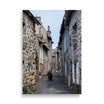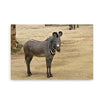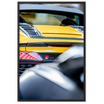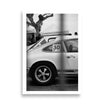Introduction to the Intersection of Visual Arts and Photography
Art, in its never-ending quest for exploration and expression, has always found ways to reinvent itself and adapt to changing times. At the heart of this development is visual arts , a field that encompasses traditional visual art forms such as painting, sculpture and drawing. These disciplines have long been pillars of artistic expression, capturing the aesthetic, emotion and vision of the artist. However, with the advent of photography in the 19th century, the spectrum of visual arts expanded, welcoming a new art form that would revolutionize the way we perceive and interact with art.
Photography, initially perceived as a simple documentation tool, has transcended its role to become an artistic medium in its own right. She introduced a new language into artistic discourse, a language that speaks through the reality captured by the lens. The first photographers were artisans, experimenters who played with light and chemicals to fix images on paper. But this was only the beginning of a fascinating story where photography would intertwine with the visual arts to create works that challenge our understanding of art and reality.
In this article, we will delve into the history of this fusion, exploring how photography was integrated and accepted into the world of visual arts. We'll examine photographic techniques that draw inspiration from traditional methods and how artists have used photography to push the boundaries of creativity. From capturing form and light to expressing abstract concepts, photography has become an essential tool for visual artists, allowing them to express themselves in ways that were not possible before.
As a visual art form, photography has not only enriched the field of visual arts, but it has also changed the way we see the world. She captured moments of truth, fragments of time that otherwise would have been lost forever. She documented history, influenced popular culture, and gave a voice to those who otherwise might not have been heard. As a witness to our times, photography is a mirror of our society, reflecting the complexities, beauties and tragedies of human existence.
As we move forward in this article, we will discover how photography continues to intertwine with the visual arts, not only as an art form, but also as a source of inspiration and technique for artists across the world.
History and Evolution of the Plastic Arts
The visual arts, a term that encompasses visual and tangible creations, have a history as old as humanity itself. From cave paintings to Renaissance sculptures, each era has seen the visual arts transform and adapt to cultural trends and technological innovations.
Brief history of the plastic arts
The history of the visual arts is rich and varied. It begins with the first artistic expressions of man, such as the cave paintings of Lascaux, which testify to a desire to represent and understand the world. Over the centuries, these arts have diversified to include a multitude of techniques and materials, from the carved marbles of Antiquity to the oils on canvas of the Baroque era.
- The visual arts have always been a reflection of human concerns, whether religious, aesthetic or philosophical.
- Each period of history has brought its share of styles and techniques, influencing future generations of artists.
The emergence of photography as an art form
Photography entered this artistic landscape in the 19th century, first as a scientific curiosity, then as a new way to explore and document reality. Pioneers of photography, such as Nicéphore Niépce and Louis Daguerre, paved the way for a new form of artistic expression.
- Photography was initially received with skepticism by the visual arts world, with some seeing it as a threat to traditional art forms.
- However, over time it has earned its place as an artistic discipline, with artists like Ansel Adams and Henri Cartier-Bresson exploring its expressive possibilities.
Photography, as an art form, has brought a new dimension to the visual arts. It has made it possible to capture fleeting moments with unprecedented precision and fidelity, providing a new perspective on the world around us.
- Photographers began experimenting with light, framing, and development to create images that went beyond mere documentation, touching on abstraction, storytelling, and emotion.
- Photographic exhibitions became common, and photographic works began to be collected and appreciated alongside paintings and sculptures.
The integration of photography into the visual arts marked a decisive turning point in the perception of what could be considered art. It has broadened the field of possibilities, allowing artists to play with reality in a way that is both authentic and imaginative.
In summary, photography has enriched the field of visual arts by offering a new form of expression that complements and challenges traditional mediums. It has made it possible to document history with unprecedented precision, while providing artists with a new language to express their vision of the world.
Photography: A Full-Fledged Artistic Medium
The recognition of photography as an artistic medium was a gradual but revolutionary process. What began as a method for capturing reality has become a powerful tool for personal expression and artistic creation.
Recognition of photography in the visual arts
Photography has long struggled to be recognized as an art. The first photographers were often scientists or inventors, but as technology became more refined, photographers began to be seen as artists.
- Debates over photography as art have been influenced by iconic exhibitions, such as those organized by Alfred Stieglitz in the early 20th century, which presented photography as a form of creative expression equivalent to painting and sculpture .
- Institutions like the Museum of Modern Art in New York began to include photography in their permanent collections, marking a shift in the institutional perception of photography as art.
Photographic techniques that borrow from traditional arts
Photography, in its artistic form, borrowed and was inspired by traditional visual arts techniques. Photographers used composition, texture, and form in similar ways to painters and sculptors, creating images that transcend the medium.
- The manipulation of light and shadow, a fundamental principle in painting, is also essential in photography to give depth and relief to the image.
- Framing and perspective, key elements of composition in drawing and painting, are equally important in creating a balanced and aesthetically pleasing photograph.
Photography also introduced unique techniques, such as long exposure and double exposure, which allowed artists to capture movement and layer images in ways that created surreal and abstract works.
- Techniques like darkroom development and the use of different types of photographic film and paper have given photographers the freedom to manipulate their images and explore varied visual effects.
- Experimenting with grain, contrast and saturation in photography can be compared to experimenting with different types of paints and canvases in the visual arts.
Photography has proven that it is not only a means of documenting the world, but also a means of interpreting and reinventing reality. Photographers, like painters and sculptors, seek to provoke an emotional response in the viewer, tell a story or convey a message through their works.
Ultimately, photography has established itself as an artistic medium in its own right, with its own rules, techniques and aesthetics. She has enriched the field of visual arts by providing a new perspective on art and opening new avenues for creative expression.
Crossed Influence between Photography and Visual Arts
The convergence of photography and the visual arts is not just a cohabitation in the art world, but a mutual influence that has enriched and expanded the boundaries of artistic creation. This interaction gave rise to hybrid works and innovative approaches that continue to shape the contemporary artistic landscape.
How photography was influenced by the visual arts
The visual arts provided a conceptual and aesthetic framework that profoundly influenced photography. Photographers borrowed elements of composition, staging and symbolism from painters, sculptors and designers, thus enriching their own visual vocabulary.
- Composition and staging : Photographers have adopted compositional techniques from the visual arts, such as the rule of thirds and the balance of elements in the frame, to create harmonious and captivating images.
- Symbolism and Themes : Just as paintings can convey symbolic messages, photographers use objects, settings, and poses to tell stories and evoke ideas.
Examples of artists who work at the intersection of these two fields
Some artists have transcended the distinction between photography and visual arts, working in both mediums or merging the techniques to create unique works.
- Man Ray : An avant-garde artist known for his surreal photographs, he used techniques like the rayogram to create images that challenge our perception of reality.
- Cindy Sherman : Using photography, she explores identity and social role through theatrical settings, where she morphs into various characters, reminiscent of character studies in classical painting.
These artists and many others have proven that photography and the visual arts are not separate entities but partners in artistic dialogue. They used photography not only to imitate the visual arts but to extend, challenge and reinvent them.
- Robert Rauschenberg : Known for his "combines", he integrated photography into his mixed media artwork, blurring the lines between painting, sculpture and printed image.
- Andreas Gursky : Contemporary photographer whose large-scale works are reminiscent of monumental paintings, with meticulous attention to composition and detail.
Photography has also influenced the visual arts, offering traditional artists new ways of seeing and thinking. She introduced a new aesthetic of reproduction and series, influencing movements like Pop Art and Minimalism.
- Andy Warhol : Using photography in his screen prints, Warhol explored repetition and mass culture, themes that have resonated in contemporary art.
Photography as a tool for visual artists
Photography also serves as an essential tool for visual artists, not only as a source of inspiration but also as an integral part of their creative process.
- Documenting the Process : Artists use photography to document the stages of their work, providing insight into the creation of a work of art.
- Final works of art : Some visual artists choose photography as the final result of their work, using the camera to capture their installations, performances, or sculptures in a way that creates a new, self-contained work.
In conclusion, the relationship between photography and the visual arts is characterized by a dynamic exchange and reciprocal influence. This synergy continues to generate artistic innovations and push the boundaries of what we consider art.
Photography in Artistic Education
The integration of photography into arts education has opened new avenues for the teaching and understanding of the visual arts. It serves not only as a means of creative expression but also as an educational medium to transmit the fundamental principles of visual art.
Integration of photography in the teaching of visual arts
Visual arts education has traditionally emphasized techniques such as drawing, painting and sculpture. However, the addition of photography to the curriculum enriched the educational experience by providing students with another perspective on artistic creation.
- Understanding Visual Elements : Photography helps students quickly understand concepts such as composition, perspective, and balance, which are essential to all visual arts.
- Technology and art : It also explores the role of technology in art, a subject that is increasingly relevant in the digital age.
Importance of photography in understanding artistic concepts
Photography, as an immediate and often more accessible medium, can serve as an entry point for students learning the visual arts. It can demystify art by making concepts more tangible and allowing for rapid and flexible experimentation.
- Exploration of light and color : Photography exercises allow students to play with light and color in experimental ways, which can be carried over to more traditional fine arts projects.
- Visual Storytelling : Photography is also a powerful tool for visual storytelling, encouraging students to develop narratives through their images, a skill that crosses all art forms.
Photography as a contemporary artistic practice
In the contemporary context, photography is often young people's first contact with art, thanks to the availability of digital cameras and smartphones. This has led to increased recognition of its importance in arts education.
- Accessibility and Expression : The ease of access to photography allows students of all ages to begin expressing their artistic ideas in an immediate and personal way.
- Interdisciplinarity : Photography is used to connect various artistic fields, acting as a bridge between visual arts, cinema, graphic design and even performance.
In conclusion, photography plays a crucial role in modern art education. It is both a learning tool and a field of study in itself, offering students the opportunity to discover and explore the visual arts in a new light. As a medium that constantly evolves with technology, photography continues to shape and redefine art education for future generations.
The Impact of Technology on Visual Arts and Photography
The advent of digital technology marked a decisive turning point in the visual arts and photography, transforming not only the methods of creation but also the dissemination and reception of works of art. This technological revolution has opened up new horizons for artists and has modified the relationship between the creator, the work and the public.
The influence of technological advances on artistic creation
Technological advances have always had an impact on the visual arts, but the digital age has accelerated this dynamic, introducing new tools and possibilities for artists.
- Digital Techniques : Digital image manipulation, 3D modeling, and 3D printing have become extensions of artists' traditional tools, enabling creations that were previously impossible.
- Accessibility and democratization : Technology has also democratized art by making creative tools more accessible and providing new platforms for sharing and selling artwork.
Digital photography as a tool for visual artists
Digital photography, in particular, has had a profound impact on the visual arts. It has changed the way artists work, from the conception to the creation of their works.
- Experimentation and iteration : Artists can experiment more freely with digital images, testing different compositions, colors and effects with unprecedented ease and speed.
- Multimedia integration : Digital photography facilitates the integration of images into multimedia works, combining photography, video, sound and interactivity to create immersive artistic experiences.
The impact on the diffusion and reception of art
Technology has also changed the way art is disseminated and perceived. Online galleries, social networks and art sales platforms have opened new channels for discovering and acquiring art.
- Social Media and Visibility : Artists use social media to reach global audiences, creating communities around their work and engaging directly with art lovers.
- Virtual art and online exhibitions : Virtual exhibitions and online museum tours have made art more accessible, allowing people around the world to experience works they might never have had the opportunity to to see in person.
Conclusion The fusion of visual arts and photography has given rise to an era of unprecedented innovation. As we move forward into the 21st century, photography continues to redefine our understanding of the arts and our world.






































































Leave a comment
All comments are moderated before being published.
This site is protected by hCaptcha and the hCaptcha Privacy Policy and Terms of Service apply.